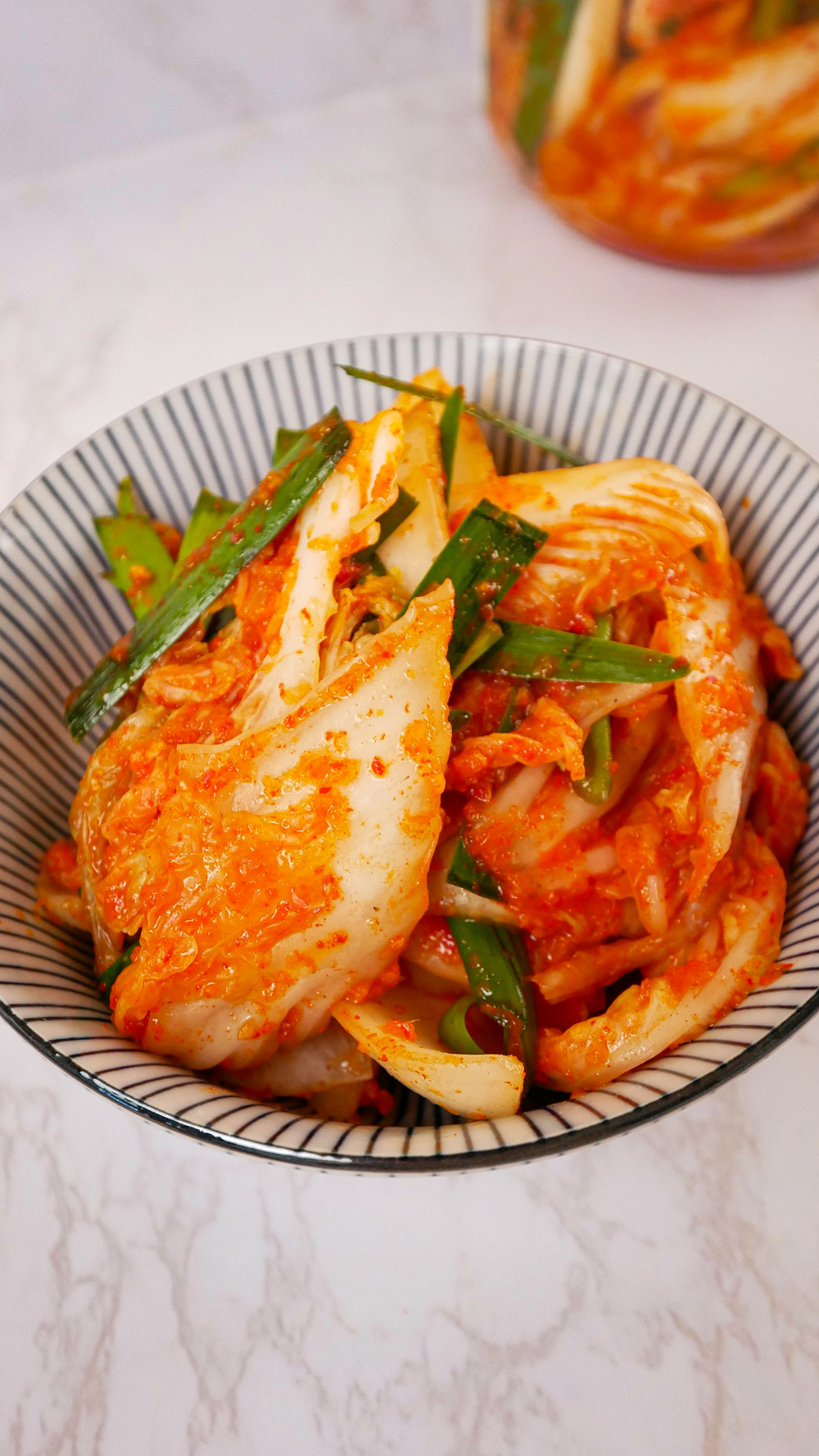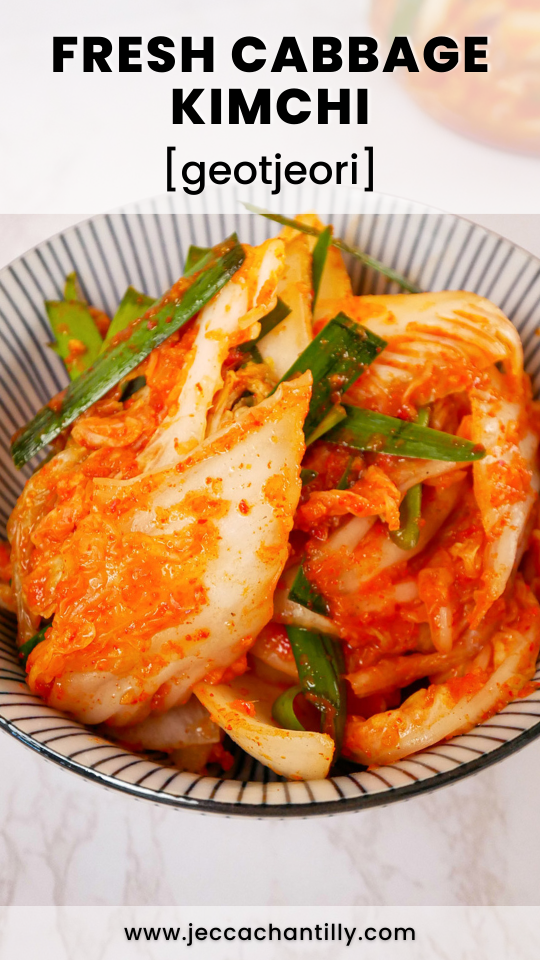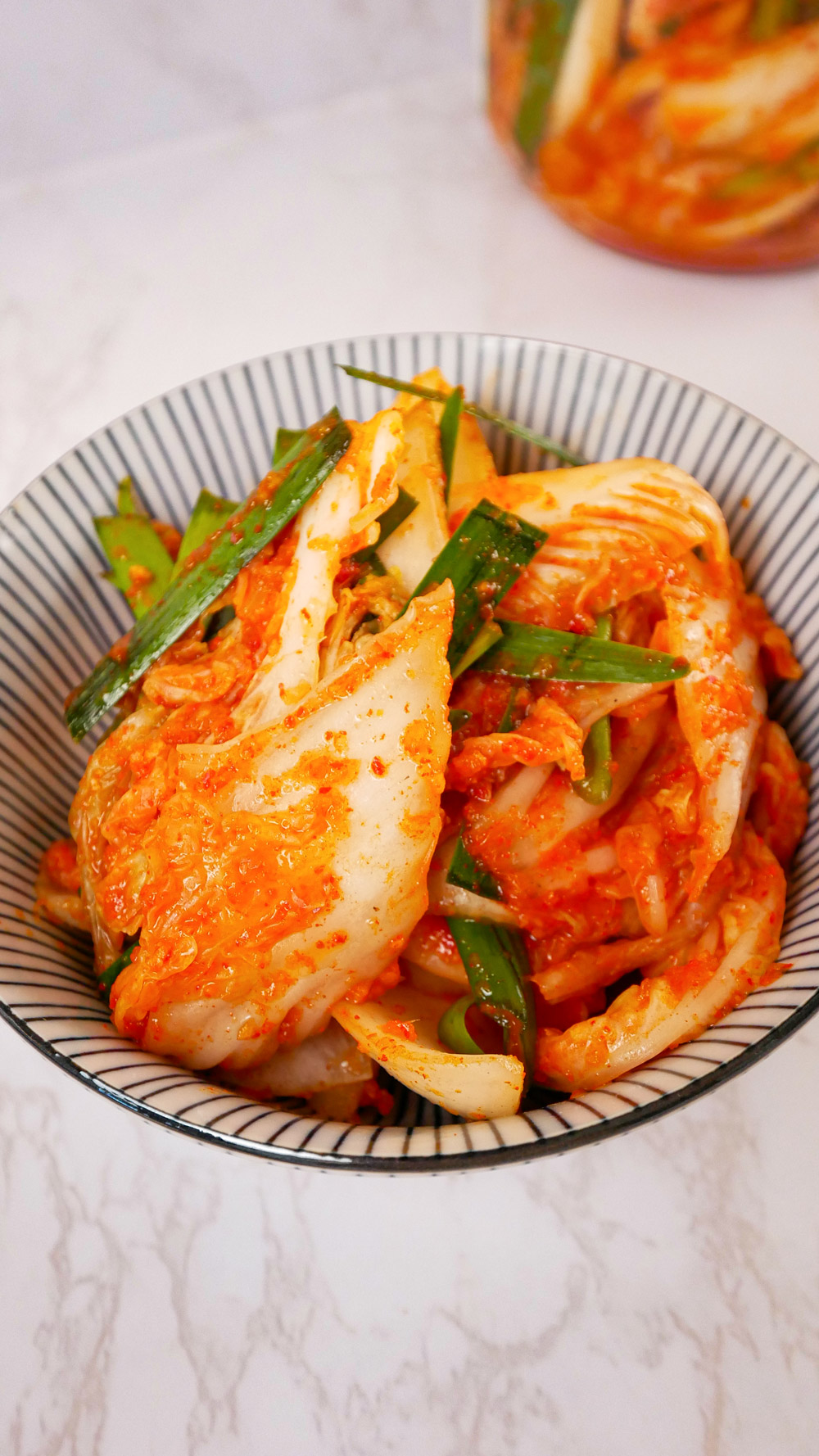Geotjeori or fresh kimchi is a delicious refreshing kimchi variety that comes together in less than half the time of regular kimchi!
Compared to most kimchi that take a couple of days to prepare, this kimchi can be eaten right away, so you don’t have to wait. It’s light, refreshing, and the perfect side dish for any meal! ☺️
Why you’ll love this recipe
If you’re craving homemade kimchi but don’t like to wait for it to ferment, you can have the best of both worlds with this recipe. Geotjeori kimchi has the spicy and salty flavors of traditional kimchi. However, since the vegetables don’t undergo the fermentation process, they retain their fresh and crisp texture in every bite!
Probably the most difficult part about this recipe is to wait for the napa cabbage to soak in the salt and water mixture. Once that’s done, you can combine it with the sauce, and you can enjoy its explosion of flavors with almost any meal.
This recipe should be enough for 6 servings, but you can easily double up the ingredients if you want to share its deliciousness with friends and family.
How do I prepare Geotjeori Kimchi?
To learn how you can easily make Geotjori Kimchi at home, just follow the steps below:
Step 1: Prepare the napa cabbage
Split the napa cabbage in half, then into quarters. Remove the core, then roughly chop the cabbage to your desired size.
Step 2: Salt the napa cabbage
Sprinkle salt over the cabbage and add about 1/4 cup of water. Then, mix thoroughly until the cabbage is evenly coated with salt and water. Set aside for at least 30 minutes or up to 1 1/2 hours.
Step 3: Rinse and squeeze the cabbage
When the cabbage is ready, rinse under cold water, then drain. Use your hands to squeeze the excess water out from the cabbage. You can also work in batches, so it’s more manageable.
Step 4: Prepare the kimchi sauce
Combine garlic, ginger, Korean radish, and the remaining 1/4 cup water in a high-speed blender. Blend them on high until smooth. If the mixture is too thick, add more water, one tablespoon at a time, or until it blends.
Step 5: Add the rest of the ingredients
Transfer the blended aromatic mixture into a bowl. Then, add gochugaru, sugar, and fish sauce. Mix together until they’re well combined.
Step 6: Combine the cabbage and sauce
In a large mixing bowl, add cabbage, garlic chives, and scallion. Pour in the sauce and mix everything together well.
Step 7: Store and chill
Transfer the kimchi to a glass jar or container with a tight lid. Then, store it in the refrigerator until chilled. Serve and enjoy!
Preparation Tips for Geotjeori Kimchi
To help make the process of making geotjeori kimchi feel like a breeze, here are a few tips you can keep in mind:
- If possible, get young napa cabbage with light yellow leaves since they’re more tender than mature cabbage.
- Don’t forget to wear gloves when mixing the napa cabbage and Korean radish with the sauce since it can get spicy!
- Make sure to spread the sauce in every crevice of the vegetables to ensure they’re evenly coated and absorb as much of their delicious flavors as possible.
- Feel free to adjust the amount of gochujang to add to the geotjeori kimchi according to your spice level.
Ingredients & Substitutions
Napa cabbage: napa cabbage is the star of this recipe, so make sure you buy fresh ones. In a pinch, you can also substitute them with green cabbage.
Salt: salt helps bring out the moisture from the napa cabbage and helps flavor them later.
Water: water dissolves the salt so you can easily coat the cabbage. Feel free to adjust the volume according to the amount of cabbage you’ll use.
Garlic chives: garlic chives add a similar garlic taste to the kimchi. You can substitute it with garlic, leeks, scallions, or shallots.
Scallions: scallions help enhance the flavors of the garlic and garlic chives. You can also use spring onion, leeks, or chives, as a substitute.
Garlic cloves: garlic cloves add an umami flavor and aroma to the kimchi. In a pinch, you can use garlic chives to add a hint of flavor.
Ginger: ginger provides an invigorating spicy flavor that balances out the flavors of the geotjeori kimchi.
Korean radish: Korean radish adds a nice crunch and a subtle sweetness to the kimchi. You can also use daikon, regular radish, jicama, or turnips as a substitute.
Gochuagru: gochugaru adds a smoky and spicy flavor to the kimchi. You can substitute it with gochujang, red chili flakes, chili powder, or paprika.
Sugar: the sweetness of the sugar balances out the salty and umami flavors of the kimchi. Feel free to use white or brown sugar for this recipe.
Fish sauce: fish sauce adds an umami flavor to geotjeori kimchi. In a pinch, you can substitute it with salt.
Ingredient variations/additions
If you’re thinking of leveling up your geotjeori kimchi, here are a few ingredient suggestions you can play around with:
1. Carrots – carrots add a crunch and a hint of sweetness to geotjeori kimchi, and it doesn’t hurt that they’re cheap and easily accessible. If you want to add them to your kimchi, cut them into matchstick pieces so they can easily absorb the flavors of the sauce.
2. Bell peppers – if you want to sneak more veggies into your geotjeori kimchi, bell peppers are an excellent pick. Use red, orange, or yellow bell peppers if you want a bit of sweetness while using green bell peppers adds a more earthy taste.
3. Pears – pears provide a buttery sweet flavor and crunchy texture to the kimchi. Their porous textures also easily soak up the sauce, guaranteeing flavor bombs with every bite. If pears aren’t in season, you can also use apples.
4. Cucumbers – if you want to make your geotjeori kimchi even more light and refreshing, you won’t go wrong with adding cucumbers. Similar to my Korean cucumber kimchi recipe, slice the cucumbers into thin strips before adding them to the kimchi.
5. Baby bok choy – baby bok choy may not be a traditional ingredient for kimchi, but it’s an excellent addition because of its mild flavor and tender texture. You can cut them in halves or quarters so they can absorb the sauce quicker and are easier to eat.
Frequently Asked Questions
Why do you salt the napa cabbage?
Adding salt to the napa cabbage at the beginning of the process helps draw out their moisture. This ensures the cabbage remains crisp even when soaked in the sauce. If you skip this step, the napa cabbage will turn soggy, and the sauce will turn watery after a few days.
What’s the difference between Korean vs. regular radish?
You’ll usually recognize Korean radish through its pale green tops that slowly fade into white. Its shape is also shorter and wider compared to regular radish, and its flesh is smoother and denser. In terms of taste, Korean radish is peppery with a hint of sweetness – while regular radish is spicy and zesty.
What is gochugaru made of?
Gochugaru is a type of Korean chili powder made from sun-dried chili peppers. They have a vibrant red color and provide a spicy and smoky flavor. It’s prominent in Korean cuisine because it can complement almost any dish, including noodles, soups, dipping sauces, seafood, and meat dishes.
How long can you store Geotjeori Kimchi?
Since geotjeori kimchi is meant to be enjoyed fresh, it’s best to consume it within 7 days. Make sure to store your kimchi in an airtight jar or container in the fridge. If you want kimchi that can last longer in the fridge, you can make my Homemade Cabbage Kimchi recipe instead!
Looking for more easy and delicious Asian-inspired recipes?
1. Kimchi Soondubu Jjigae – for a spicy and hearty stew, you don’t want to skip out on this recipe. It’s packed with bold flavors, from spicy kimchi, tender pork, and silky tofu, that’ll guarantee to warm your body and soul.
2. Beef Enoki Rolls – this spicy and savory beef enoki roll recipe is the perfect weeknight meal. It may only take 20 minutes and one pot to whip up, but it’s incredibly good you’ll want to put this on repeat.
3. Bossam (Korean Boiled Pork Belly) – whether you want to celebrate a big life milestone or reward yourself for conquering a small task, there’s no better time to indulge yourself in a plate of Bossam! Although the juicy pork already tastes delicious on its own, the experience won’t be complete without my Bossam sauce on the side.
4. Honey Butter Fried Chicken – one bite out of this dish, and you won’t be able to get enough of this crispy-fried chicken recipe. The juicy fried chicken is smothered in a sweet and indulgent honey buttery sauce for the ultimate comfort meal.
5. Gochujang Pasta with Shrimp – if you’re in the mood for something special, elevate your pasta nights with this spicy recipe. Gochujang and shrimp make an indulgent combo that provides an explosion of flavors in your mouth.

Geotjeori Kimchi
Ingredients
- 1 napa cabbage about 2 1/2 lbs
- 2 tbsp salt
- 1/2 cup water divided
- 1 cup garlic chives chopped into 2 inch pieces
- 3 scallions chopped into 2 inch pieces
- 12 garlic cloves
- 1/2 inch ginger
- 1/2 cup Korean radish
- 1/4 cup gochugaru adjust according to spice tolerance
- 2 tbsp sugar
- 6-8 tbsp fish sauce adjust to taste
Instructions
- Split the napa cabbage in half, then into quarters. Remove the core then roughly chop the cabbage to your desired size.
- Sprinkle salt over the cabbage and add about 1/4 cup of water. Mix thoroughly until cabbage is evenly coated with salt and water. Set aside for at least 30 minutes or up to 1 1/2 hours.
- When the cabbage is ready, rinse under cold water then drain. Using your hands, squeeze the excess water out from the cabbage. Work in batches so it's more manageable.
- Combine garlic, ginger, Korean radish, and remaining 1/4 cup water into a high speed blender. Blend on high until smooth. If the mixture is too thick, add more water one tablespoon at a time until it blends.
- Transfer the blended aromatic mixture into a bowl. Add gochugaru, sugar, and fish sauce. Mix together until well combined.
- In a large mixing bowl, add cabbage, garlic chives and scallion. Pour in the sauce and mix everything together well.
- Transfer to a glass jar or container with a tight lid. Store in the refrigerator until chilled and enjoy!
Pin & save this recipe for later!

